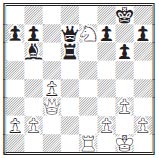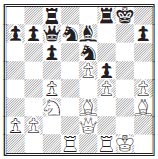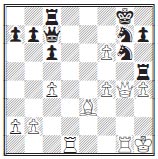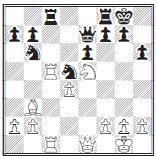| | Alex Relyea and Nita Patel brought us the 2012 Portsmouth Open, with new time controls this year of 40 moves/90 minutes, then Game/30, with an increment of 30 seconds added after each move.
In the Open section, Grandmaster Alexander Ivanov took first, while International Master David Vigorito and Ted Belanoff (the sole 3-0 going into the fi nal round) split 2nd/top Under 2250. Niccolo Hilgendorf was top Under 2000.
In the Under 1750 section, Harry Van Der Keyl and Michael Corrigan split 1st/2nd, Eric Heinicke was top Under 1500, and Jamie Segee-Wright was top Under 1250.
John Gaspar 1958
Niccolo Hilgendorf 1843
Portsmouth Open 2012 (4)
[A48] King’s Indian Defense
1. d4 Nf6 2. Nf3 g6 3. Bg5 Bg7 4. e3 O-O 5. Bd3 d6 6. Nbd2 Nbd7 7. c3 c5 8. Qc2 b6 9. O-O-O Bb7 10. h4 h5 11. Kb1 a5 12. Nf1 Ba6 13. Bxa6 Rxa6 14. Qe2 Qa8 15. Ng3 b5 16. e4 e5 17. dxe5 dxe5 18. Rd2 c4 19. Bxf6 Nxf6 20. Rhd1 b4 21. Qxc4 bxc3 22. bxc3 Rc6 23. Qd3 Rfc8 24. Rc2 Qb7+ 25. Ka1 Qc7 26. Ng5 Bf8 27. f3 Bb4 28. Ne2 Rd6 29. Nd4 Bxc3+ 30. Rxc3 Qxc3+ 31. Qxc3 Rxc3 32. Kb2 Rxd4 33. Rf1 Rc6 34. f4 Rb4+ 35. Ka1 Nxe4 36. fxe5 Nxg5 0-1
John Gaspar 1958
Vadim Martirosov 2360
Portsmouth Open 2012 (1)
[D04] Colle System
1. d4 d5 2. Nf3 Nf6 3. e3 c5 4. dxc5 e6 5. b4 a5 6. c3 b6 7. a4 axb4 8. cxb4 bxc5 9. b5 Bd6 10. Bb2 O-O 11. Bd3 Nbd7 12. Nbd2 Bb7 13. Qe2 Ne4 14. O-O f5 15. Bc2 Bc7 16. Rfd1 Qe8 17. Nf1 Ba5 18. Bxe4 fxe4 19. Ne5 Rf5 20. Nxd7 Qxd7 21. Ng3 Rf7 22. Nxe4 Qe7 23. Ng3 Raf8 24. f3 Qg5 25. Ba3 Rc8 26. Rac1 Rfc7 27. Qd3 Qh4 28. e4 Bb6 29. Kh1 c4 30. Qe2 c3 31. exd5 Bxd5 32. Rxd5 exd5 33. Qe6+ Kh8 34. Qxb6 Qxa4 35. Bd6 Rd7 36. Be5 Qa3 37. Rxc3 Qa1+ 38. Qg1 Qxg1+ 39. Kxg1 Rxc3 40. Bxc3 Rb7 41. Nf5 Rxb5 42. Bxg7+ Kg8 43. Bd4 Rb4 44. Nh6+ 1-0
Michael Corrigan 1724
Mark Seedner 1585
Portsmouth Open 2012 (3)
[C07] French Defense
1. d4 d5 2. e4 e6 3. Nd2 c5 4. c3 Nc6 5. dxc5 Bxc5 6. Nb3 Bb6 7. exd5 exd5 8. Nf3 Bg4 9. Be2 Nf6 10. O-O O-O 11. Bg5 Re8 12. Qc2 Qd6 13. Rad1 Bc7 14. g3 Ne5 15. Nbd4 Rad8 16. Bf4 Qe7 17. Rfe1 Bxf3 18. Bxf3 Nxf3+ 19. Nxf3 Qc5 20. Rxe8+ Rxe8 21. Be3 Qe7 22. Nd4 Ng4 23. Nf5 Qe6 24. Qd3 Nxe3 25. Nxe3 Bb6 26. Nxd5 Rd8 27. c4 g6 28. Qc3 Rd6 29. Re1 Qd7 30. Ne7+

1-0 (30...Kf8 31 Qh8#)
Jamie Segee-Wright 1001
Mark Seedner 1585
Portsmouth Open 2012 (1)
[C02] French Defense
1. e4 e6 2. d4 d5 3. e5 c5 4. Nf3 Nc6 5. c3 Bd7 6. Bf4 Qb6 7. Qb3 cxd4 8. Qxb6 axb6 9. Nxd4 Bc5 10. Bb5 Nxd4 11. Bxd7+ Kxd7 12. cxd4 Bxd4 13. Nc3 Bxc3+ 14. bxc3 Ra4 15. Be3 Ne7 16. O-O Rha8 17. Rab1 Rxa2 18. Rxb6 Kc8 19. Rfb1 Nc6 20. Rxb7 Ra1 21. h3 Rxb1+ 22. Rxb1 Nxe5 23. Bd4 f6 24. Bxe5 fxe5 25. Re1 e4 26. f3 Ra4 27. fxe4 Rxe4 28. Rxe4 dxe4 and eventually 1/2-1/2
As Mark good-naturedly commented later about this draw’s effect on his rating, “That’s going to hurt.”
A View from the Bottom of the Open Section Barrel
At last year’s event, I remember standing around with a few folks including GM Alexander Ivanov, and TD Ken Ballou, if memory serves, discussing delay/increment. Ivanov expressed his opinion that unless it was 30 seconds or more, it didn’t help much. Having now tried such an increment, I have to say I really like it.
Not that it necessarily led to my making better moves, but as my time ran down, it felt much more comfortable (civilized?) to know that I’d always have at least 30 seconds to make my next move. In my fi rst round against John Elmore, I had 5 minutes and 51 seconds left after my 38th move. After making my 39th move, I was mentally congratulating myself on now having 6 minutes and 3 seconds (i.e., a little more time than after the previous move)...until I realized I had just played a gross blunder. I was, however, probably already losing, down the exchange with a bad position and my king under attack.
John’s “Enjoy the game.” sentiment at the start of that game was a sparkling alternative to the standard “Good luck.” (which I have probably always used). Before a round’s pairings are posted, that standard sentiment often becomes the wrybut-well-worn variant “Good luck, unless you’re playing me later.” Although wins are certainly better than draws or losses, my real desire is simply to enjoy each game, and I hope to remember to utter John’s sentiment myself in the future.
After having lost the game to John, I was out for the between-round meal, but hurried back from a halfeaten plate only to discover that I had a bye in round 2. Being the bottom player in the Open section with my 1800 rating, I should have been more aware of that possibility, but I suppose even earlier I hadn’t been thinking super clearly about some normal aspects of weekend tournament play, something in which I rarely participate. Indeed, I had been surprised to realize that I had forgotten to bring my chess set, although I had brought my chess clock. I’m most often playing one round/night at the Boylston Chess Club, where a clock is all I need to bring.
I was, however, able to play an extra game during round 2 with house player Richard Judy (1949), who I last played 20 years ago. Although there were plenty of mistakes, our game was somewhat picturesque, and we landed in the following position after 22…gxf5:

I had been planning 23 Ne4 (23... fxe4 24. Bxe6+ followed by 25 Rxd7, winning more material). Suddenly (and quite wrongly) I thought I had an even more direct way of winning material, and I played 23 Bxf5?, after which 23...Rxf5 24 Qg4+ was answered by 24...Ng7, a move which I had lamely overlooked. The game continued: 25 Kh1 Nf8 26 Rg1 Ng6 27 Ne4 Rh5 28 Nf6+ Bxf6 29 exf6

As I related to Richard the next day, I had been salivating for him to play the visually tempting but wrong 29...Rxh4+??, when 30 Qxh4 Nxh4 31 Rxg7+ Qxg7 32 fxg7 is winning for White. He saw that, too, and played: 29...Rd8 After my 23rd move error, I had been worried I was going down in fl ames, and for a period of time here I thought the end was near. Eventually I snapped out of it and realized that I did not have to play 30 Rxd8, retaining more chances. 30 Rdf1 Qf7 31 f5 Nxh4 (31...Qxf6 32 Bg5) 32 Qxg7+ Qxg7 33 Rxg7 Kh8 34 Rg5 Nxf5+ 35 Rxh5 Ng3+ 36 Kg2 Nxh5 37 f7 Rf8 38 Bc5 Kg7 39 Bxf8+ Kxf8 and White has a winning ending. 40 Rd1 Nf6 41 Rd8+ Kxf7 42 Rb8 1-0.
The next day Richard mentioned in passing (en passant?) that Houdini showed a win for him in a position with his queen on f7. I am no tactician, so I will leave possible variations up to the reader….
In the third round I was taken totally unaware by a nice move from Kira Storm (1989). Because it didn’t win any material, he wasn’t totally happy classifying it as a combination, but I would definitely do so. When Kira played the move, I sat there appreciating its strength, thinking, “Wow, I am getting beaten by a beautiful combination!”
After 22...Nf5-d5?:

23 Ng6! 23...fxg6 24 Bxd5 I had miscalculated, and thought that 24 Rxc8? was the right move. In fact, as Kira pointed out in the postmortem, 24...Rxc8 25 Rxc8 Nxc8 protects the queen (I had overlooked that), so 26 Bxd5 exd5 would simply lose for White. And 24...Nxc8 25 Rxc8? Rxc8 26 Bxd5? exd5 27 27 Qxe7?? Rc1+ 28 Qe1 Rxe1# (It’s so easy to deliver back rank mate when you assign multiple bad moves to your opponent!). Because of my incorrect assessment of 24 Rxc8, when Kira played the text move, I thought he had overlooked something and excitedly thought I was on my way to an unexpected win. After 24...Rxc5 25 Bxe6+ Qxe6 I thought I would be delivering back rank mate, realizing as I made the move that White’s recapture of the queen would be with check, so I resigned. Instead of the auto-destruct 25...Qxe6, a reasonable continuation we looked at was 25...Kh8 26 dxc5 Na4 27 Bb3 Qxe1+ 28 Rxe1 Nxc5 29 Bc2 when White has an endgame edge, but Black may suffer his way to a draw.
After the tournament was over, I had the pleasure in the hotel lobby of listening to Dave Vigorito’s comments to Vadim Martisirov re: opening move order fi nesses, which was a fascinating dessert to top off a very enjoyable tournament! A big thanks to Alex and Nita!
|